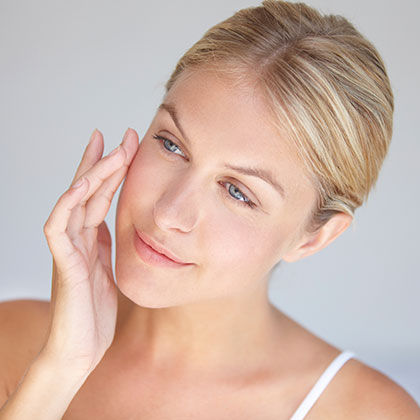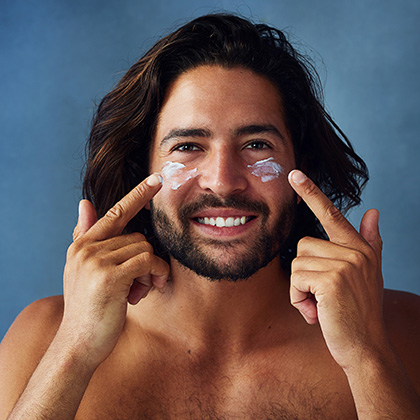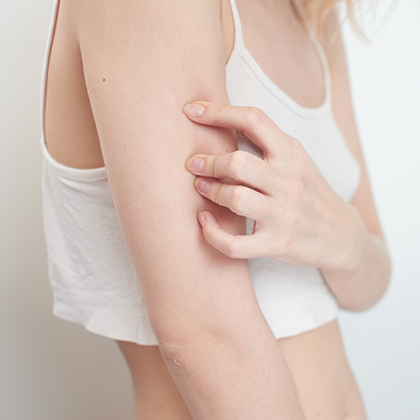When summer comes along, it’s only natural to want to spend more time outdoors. The feeling of the sun’s warmth on your skin is arguably one of life’s great pleasures. And it doesn’t just feel good. In fact, some sun exposure is good for you as it helps your body to produce vitamin D.
But spend too much in the time without protecting your skin and you could be left with sunburn. This is thought to be caused by ultraviolet (UV) radiation acting on the skin to produce harmful substances called free radicals – a process that could also lead to changes in your skin’s cells that may, in time, trigger skin cancer. As such, it’s always important to use sun protection to defend your skin against the sun’s damage.
Skin-damaging radiation
There are three types of UV wavelengths that make up UV radiation – the part of the light spectrum that reaches the earth from the sun – namely UVA, UVB and UVC. These wavelengths are shorter than visible light, which means we can’t see it.
UVA
This is the longest of the three wavelengths and most people are exposed to large amounts of it during their lifetime (UVA rays make up around 95 per cent of the radiation that reaches the earth’s surface(i)).
Experts believe this is the type of UV radiation that’s linked with skin ageing, and it’s thought to lead to wrinkles, leathery skin and brown spots (age spots or sun spots, as they’re sometimes known). UVA rays can penetrate clouds and glass, so they can affect you even when it’s not sunny or when you’re indoors or in your car.
According to the Skin Cancer Foundation in the US, UVA was once thought to be safe but it’s now known that over time it can lead to skin cancer. That’s because exposure to UVA causes genetic damage to cells on the innermost part of the top layer of skin, where most skin cancers occur (i).
In sunscreen products, UVA protection is shown as a UVA star rating (0 is the lowest, five is the highest). Using a sunscreen product with a high level of stars can help protect your skin against photo ageing and also against skin cancer.
UVB
Most responsible for ski reddening and sunburn, UVB damages the more superficial layers of the skin and is strongly linked to an increased risk of types of skin cancers called malignant melanoma and basal cell carcinoma. Unlike UVA, UVB rays can be filtered and are not thought to penetrate glass (i).
SPF
SPF - which stands for sun protection factor – reveals the level of protection in a sunscreen product against UVB. The higher the SPF number, the stronger the protection.
UVC
Most of these rays are absorbed by the earth’s ozone layer, and they’re not thought to play any part in the development of sunburn or skin cancer.
Exposure to too much UVB can result in sunburn, where your skin can turn red, blister, peel and feel painful. This, in fact, is caused by blood vessels swelling and bringing more blood into the damaged area of your skin – it’s your body’s way of repairing itself.
How quickly your skin reacts to excessive sun exposure can vary – one person may feel their skin burning and turning red within about 15 minutes while others may take several hours to feel any after-effects. Usually, sunburn peaks within 12 or 24 hours after sun exposure, with pain usually at its worst around six to 48 hours after exposure. Your skin may start to flake within three to eight days, and some people may continue to peel for weeks afterwards (ii).
Sunburn: know your risk
According to Cancer Research UK, your risk of sunburn depends on how sun-sensitive your skin is and how strong the UV rays are that you’re exposed to (iii). One person’s risk of getting sunburned on any particular day may be different to that of someone else. To protect your skin as effectively as possible, it’s a good idea to know what your skin type is and when you’re more likely to be vulnerable to burning.
There are six different skin types that have been identified with respect to how they react to the sun:
-
Type 1
This type burns easily and rarely gets a tan. People with type 1 skin tend to have freckles, red or fair hair and blue or green eyes. -
Type 2
If you have type 2 skin, you may tan sometimes but you usually burn in the sun. Your hair will probably be light and your eyes may be blue or brown. -
Type 3
Your skin usually tans, but you may burn sometimes too. If you have type 3 skin, it’s likely that your hair and your eyes will be brown. -
Type 4
This type rarely burns. Your hair and eyes will probably be dark brown. -
Type 5
Your skin will be naturally brown, and your eyes and hair usually dark brown. -
Type 6
This is the type for naturally black and brown skin, with black-brown eyes and hair.
Once you’ve worked out your skin type, check it against the UV index (iv). This index has been devised by weather forecast experts, and is colour coded with numbers:
-
Grey (0) is no risk
-
Green (1-2) is low risk
-
Yellow (3-5) is moderate risk
-
Orange (6-7) is high risk
-
Red (8-10) is very high risk
-
Purple (11) is extreme risk
In the UK, the UV index rarely exceeds 8 (red), but in some parts of the Mediterranean, indices of 9 and 10 are common. Here’s what your risk of burning is according to your skin type and the UV index:
-
UV index 1-2 (green): Low burning risk for all skin types.
-
UV index 3-4 (yellow): Medium risk of burning for types 1 and 2, low risk for all other types.
-
UV index 5 (yellow): High risk of burning for types 1 and 2, medium risk for types 3 and 4 and low risk for types 5 and 6.
-
UV index 6 (orange): High risk of burning for types 1 and 2, medium risk for types 3, 4 and 5, low risk for type 6.
-
UV index 7-9 (orange, red): Very high risk of burning for types 1 and 2, high risk for types 3 and 4, medium risk for types 5 and 6.
-
UV index 8 (red): Very high risk of burning for types 1 and 2, high risk for types 3,4 and 5, medium risk for type 6.
Check out the UV index for today’s UK weather at the Met Office website. Meanwhile, you can learn more about burns and scalds can effect on your skin, and how to treat them.
How to treat sun-damaged skin
As soon as you notice your skin has started to burn, the first thing you should do is get out of the sun (stay in the shade or go indoors and away from strong sunlight shining through windows). If your sunburn is mild, you shouldn’t need to see your GP and can treat it yourself at home (see below for information on when you should seek medical advice).
Here are some of the things you can do to soothe your skin and help it to heal:
Cool it
Take a cool bath or shower to keep bring the temperature of your skin down, and/or use cold compresses on the affected areas (dampen a towel or similar with cool water, never apply ice directly to your skin). Avoid using soap or perfumed products in the bath or shower, as they could dry your skin out further.
Drink up
Make sure you don’t become dehydrated by drinking plenty of fluids. When your skin is burned, it draws fluid to its surface and away from the rest of your body, so replenish that fluid regularly. Drinking cool fluids – water, milk, diluted juice, iced herbal tea etc – may also help cool your body down.
Apply moisture
Keep your skin hydrated by applying a water-based moisturiser or aloe vera lotion/gel (avoid oil-based creams or ointments, as they could trap the heat and make the burn worse). Try to apply it when your skin is still damp (after having a shower or applying cold compresses, for instance). Do this several times a day while your skin is recovering. Applying calamine lotion or after-sun lotion may also provide some relief.
Relieve pain
If your skin is sore and uncomfortable, an over-the-counter painkiller such as paracetamol or ibuprofen may provide relief. Do not, however, give aspirin to children under the age of 16 (if you’re giving painkillers to children, always make sure you give them the right product and correct dosage for their age).
Try home remedies
There are various things found around the home that you could use to soothe your skin, including cool (but not cold) milk or yoghurt, freshly brewed and cooled tea, sliced cucumbers (or mash slices up to make a paste) and even cooled mashed potato (the starch in potatoes is thought to help draw out heat from the skin).
Leave blisters alone
Don’t try to burst any blisters that may form on your skin, as it can slow down the healing process as well as increase the risk of infection. If a blister does break, clean the area with water and apply an antiseptic cream.
Keep your skin under wraps
To protect any sunburned skin from further damage as a result of sun exposure, either stay out of the sun as much as possible until it has healed or cover up as much of your body as you can if you have to go outdoors.
Sunburn: when to see your GP
If your sunburn is more severe, especially if you have a high temperature, it’s important to get medical attention. You should also watch out for signs of heat exhaustion and heat stroke.
Heat exhaustion means your body has become very hot, but heatstroke is more serious as your body can no longer cool itself, and your temperature could become dangerously high. The signs of heat exhaustion to look out for include the following:
-
Faintness or dizziness
-
Tiredness
-
Headache
-
Nausea and/or vomiting
-
Muscle cramps
-
Loss of appetite
-
Palpitations/fast pulse rate
-
Heavy sweating
-
Intense thirst
-
Dark-coloured urine
According to the NHS, it’s important to cool someone down if they’re showing signs of heat exhaustion: lie them down in a cool place and use wet sponges or flannels to cool their skin (you could also wrap them in a cool wet sheet and put cold packs around their neck and armpits). Make sure they drink plenty of fluids, and if they don’t start feeling better within 30 minutes contact their GP (v).
If they still feel unwell after resting in a cool place and drinking plenty of water for 30 minutes, they may have heatstroke, which can be very serious if not treated quickly. Other signs of heatstroke include:
-
A high temperature of 40C or higher
-
Shortness of breath or rapid breathing
-
Confusion
-
Not sweating
-
Seizure
-
Unconsciousness
Natural relief for sun-damaged skin
Safeguarding yourself against the sun by staying in the shade, using sunscreen and wearing protective clothing is the best approach when it comes to avoiding sunburn. There are also some natural remedies that may help reduce sun damage. These include the use of antioxidant supplements to protect the skin from UV radiation and soak up the free radicals produced in the skin as a result of excess sun exposure:
Vitamins A, C and E
These antioxidant vitamins are believed to neutralise free radicals in the blood and other parts of the body, and some scientists believe they may also provide similar protection in the skin too. Indeed, studies suggest the level of vitamins C and E in skin cells become lower following sun exposure (vi). Scientists elsewhere claim taking vitamin C and vitamin E may provide modest relief of redness in skin caused by sun exposure (vii).
Green tea extract
Green tea contains high levels of powerful antioxidant substances called catechin polyphenols, which are thought to help protect the skin from sun damage when applied directly to the skin (viii). These substances are thought to work by protecting cells from some of the damage caused by UV light, rather than physically blocking it.
Lutein
An antioxidant found in green vegetables, lutein is thought to act as a natural sunblock. There is, in fact, some evidence that lutein may help protect against UV-induced skin damage (ix).
Anthocyanidins
Found in the pigments of dark and richly coloured fruit such as blueberries, blackberries, raspberries and red grapes as well as pine bark and grape seed extract, anthocyanidins are believed to block the action of free radicals in skin cells. In one study, volunteers took a supplement of pine bark extract (pycnogenol). After just four weeks of taking the supplements, they found they needed to stay in the sun for longer before their skin turned red, compared to when they hadn’t started taking the supplements (x).
Lavender oil
Traditionally, lavender essential oil has been used to treat a number of skin conditions, including burns. If your skin feels uncomfortable as a result of too much sun exposure, try taking a cool bath with a few drops of lavender essential oil, or dilute up to 12 drops in 30ml grapeseed oil (or another carrier oil) and apply directly to your skin.
While it may take a little extra time, ensuring that you protect you skin from the sun’s harmful rays can be worthwhile in the long run. To discover even more information on how to maintain your overall health, feel free to visit our health library.
References:
-
Available online: https://www.skincancer.org/risk-factors/uv-radiation/
-
Available online: https://www.medicalnewstoday.com/articles/176441.php#sunburn_symptoms
-
Available online: https://www.cancerresearchuk.org/about-cancer/causes-of-cancer/sun-uv-and-cancer/am-i-at-risk-of-sunburn
-
Available online: https://www.who.int/uv/intersunprogramme/activities/uv_index/en/
-
Available online: https://www.nhs.uk/conditions/heat-exhaustion-heatstroke/
-
Darr D, Combs. S, Dunston. S. Topical vitamin C protects porcine skin from ultraviolet radiation-induced damage. Br J Dermatol 1992;127:247-253.
-
Werninghaus. K, Meydani. M, Bhawan. J, et al. Evaluation of the photoprotective effect of oral vitamin E supplementation. Arch Dermatol 1994;130:1257-1261.
-
Eberlein-Konig. B, Placzek. M, Przybilla. B. Protective effect against sunburn of combined systemic ascorbic acid (vitamin C) and d-alpha-tocopherol (vitamin E). ). J Am Acad Dermatol. 1998;38:45-48.
-
Katiyar. SK, Matsui. WA, Elmets. CA, et al. Polyphenolic antioxidant (-)-epigallocatechin-3-gallate from green tea reduces UVB-induced inflammatory responses and infiltration of leukocytes in human skin. Photochem Photobiol. 1999;69:148-153.
-
Elmets. CA, Singh. D, Tubesing. K, et al. Cutaneous photoprotection from ultraviolet injury by green tea polyphenols. J Am Acad Dermatol. 2001;44:425-432.
-
Rabinovich. CA,Kazlouskava V, Herbal sun protection agents: Human studies. Clin Dermatol. 2018 May - Jun;36(3):369-375. Available online: https://www.ncbi.nlm.nih.gov/pubmed/29908579
-
Roberts. RL, Green. J, Lewis. B, et al. Lutein and zeaxanthin in eye and skin health. Clin Dermatol. 2009 Mar-Apr;27(2):195-201.
-
Grether-Beck. S, et al. Molecular evidence that oral supplementation with lycopene or lutein protects human skin against ultraviolet radiation: results from a double-blinded, placebo-controlled, crossover study. Br J Dermatol. 2017 May;176(5):1231-1240. Available online: https://www.ncbi.nlm.nih.gov/pubmed/27662341
-
Saliou. C, Rimbach. G, et al. Solar ultraviolet-induced erythema in human skin and nucelar factor-kappa-B-dependent gene expression in keratinocytes are modulated by a French maritime pine bark extract. Free Radic Biol Med. 2001 Jan 15;30(2):154-60.
Related Posts
Disclaimer: The information presented by Nature's Best is for informational purposes only. It is based on scientific studies (human, animal, or in vitro), clinical experience, or traditional usage as cited in each article. The results reported may not necessarily occur in all individuals. Self-treatment is not recommended for life-threatening conditions that require medical treatment under a doctor's care. For many of the conditions discussed, treatment with prescription or over the counter medication is also available. Consult your doctor, practitioner, and/or pharmacist for any health problem and before using any supplements or before making any changes in prescribed medications.

Christine
Christine Morgan has been a freelance health and wellbeing journalist for almost 20 years, having written for numerous publications including the Daily Mirror, S Magazine, Top Sante, Healthy, Woman & Home, Zest, Allergy, Healthy Times and Pregnancy & Birth; she has also edited several titles such as Women’ Health, Shine’s Real Health & Beauty and All About Health.
View More



